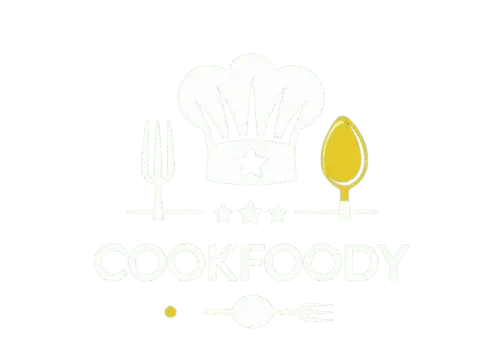French Toast Breakfast has become the crown jewel of weekend mornings, but are you tired of soggy, flavorless results that leave your family disappointed? This classic French Toast Breakfast recipe transforms ordinary bread into golden, custardy perfection that will have everyone asking for seconds. Hi there! I’m Lisa from Recipesrealm, and after countless morning experiments in my kitchen, I’ve perfected this foolproof method that creates restaurant-quality French toast every single time.
As someone who’s spent years perfecting breakfast recipes, I understand the frustration of French toast that’s either too soggy in the middle or too dry on the outside. This recipe eliminates those common pitfalls through precise timing and technique. You’ll discover the secrets to achieving that perfect balance of crispy exterior and creamy interior, plus I’ll share professional tips for bread selection, batter consistency, and cooking temperature that make all the difference.
In this comprehensive guide, we’ll explore everything from choosing the ideal bread thickness to mastering flavor variations that cater to every palate. Whether you’re planning a special family brunch or looking to elevate your everyday breakfast game, this French Toast will become your go-to morning masterpiece.
Why This French Toast Breakfast Recipe Works
This French Toast recipe succeeds where others fail because it focuses on three fundamental elements: flavor depth, foolproof technique, and incredible versatility. After testing dozens of variations, I’ve discovered the perfect formula that delivers consistent results every time.
The magic lies in our enhanced custard base that penetrates every fiber of the bread without creating that dreaded soggy center. Here’s why this recipe stands apart:
• Uses everyday ingredients you already have – No need for specialty items or expensive additions • Ready in just 20 minutes – Perfect for busy mornings when you want something special • Feeds a crowd easily – Scale up effortlessly for family gatherings or weekend brunches • Customizable to any taste preference – From classic vanilla to exotic spice blends • Works with various bread types – Adaptable whether you prefer brioche, challah, or simple sandwich bread • Creates the perfect texture balance – Crispy golden exterior with a creamy, custard-like interior
The key difference in this French Toast Breakfast approach is the overnight soaking option for extra-thick slices and the temperature control method that ensures even cooking throughout. This technique eliminates the common problem of burnt exteriors with raw centers.
Choosing the Right Bread for Your French Toast Breakfast
The foundation of exceptional French Toast Breakfast lies in bread selection. Not all breads are created equal, and understanding which types work best can transform your breakfast experience from ordinary to extraordinary.
Best Bread Types for This French Toast Breakfast Recipe
Brioche: The gold standard for French Toast , brioche offers rich butter content and sturdy structure that absorbs custard beautifully while maintaining integrity during cooking. Its slightly sweet flavor complements the egg mixture perfectly.
Challah: This egg-rich bread provides excellent absorption properties and creates a luxuriously thick French Toast Breakfast. The braided loaves offer consistent thickness and exceptional flavor development.
Texas Toast: Pre-sliced thick bread that’s specifically designed for French toast applications. While not as rich as brioche, it’s readily available and produces reliable results.
Day-Old French Bread: Slightly stale French bread works wonderfully as it won’t fall apart during soaking and creates a rustic, hearty French Toast Breakfast experience.
Buying Tips for Perfect French Toast Breakfast Bread
When shopping for your French Toast Breakfast ingredients, look for bread with these characteristics:
- Thickness: Aim for slices between ¾ to 1 inch thick for optimal custard absorption
- Density: Choose bread with a tight crumb structure that won’t disintegrate when soaked
- Freshness: Day-old bread actually works better than fresh, as it absorbs liquid without becoming mushy
- Size: Uniform slice sizes ensure even cooking across your entire French Toast Breakfast batch
Bread Substitutions for French Toast Breakfast Variations
For Gluten-Free Options: Substitute with thick-cut gluten-free bread, allowing extra soaking time for proper absorption.
For Lower Carb: Use thick-sliced keto bread or cloud bread for a lighter French Toast alternative.
For Whole Grain: Whole wheat or multigrain breads work well but may require slightly longer soaking times and gentler cooking temperatures.
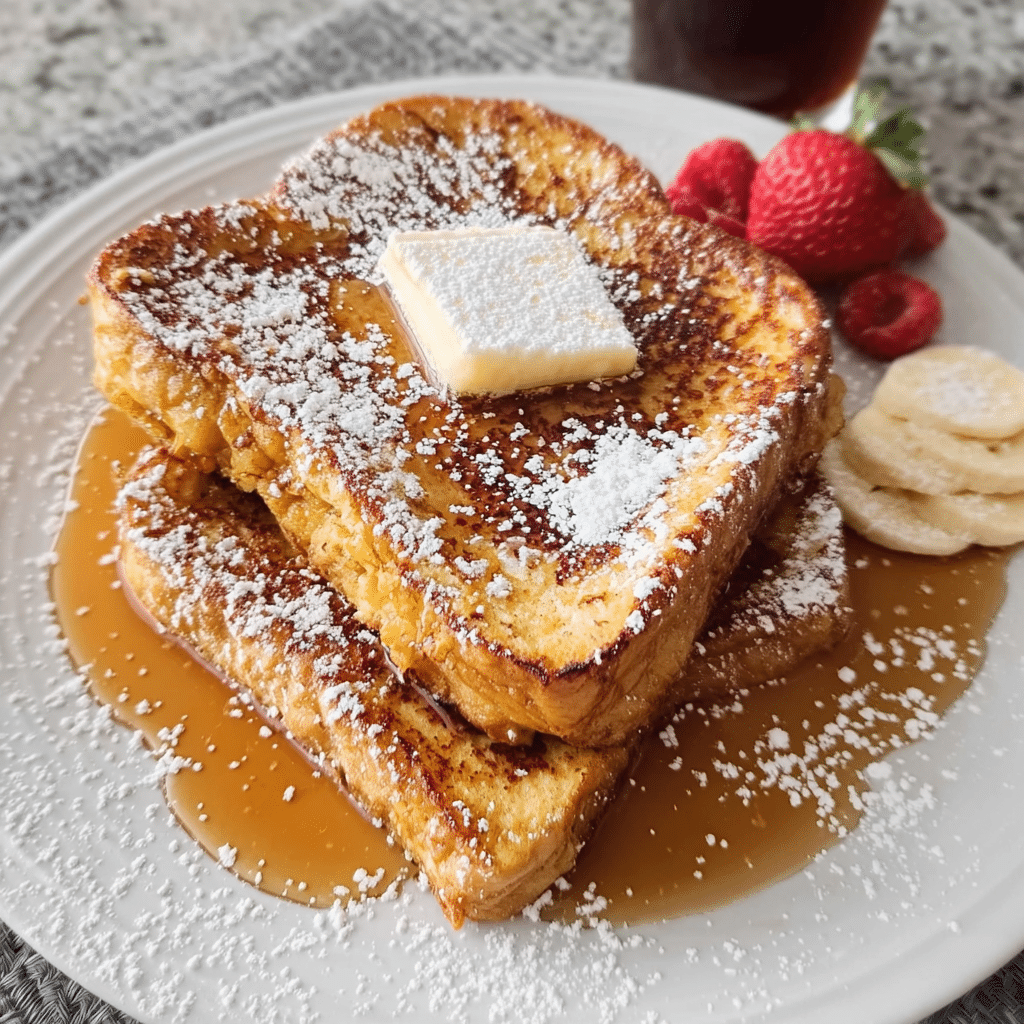
Ingredients & Prep for Classic French Toast Breakfast
Creating the perfect French Toast Breakfast starts with understanding each ingredient’s role in the final dish. This section breaks down everything you’ll need and how to prep for success.
Essential French Toast Breakfast Ingredients
For the Custard Base:
- 6 large eggs (room temperature for better mixing)
- 1 cup whole milk (creates richness and proper consistency)
- ¼ cup heavy cream (adds luxurious texture)
- 2 tablespoons granulated sugar (balances flavors)
- 1 teaspoon vanilla extract (pure vanilla only)
- ½ teaspoon ground cinnamon (freshly ground preferred)
- ¼ teaspoon salt (enhances all other flavors)
- Pinch of nutmeg (optional but recommended)
For Cooking:
- 2 tablespoons unsalted butter (for the pan)
- 8-10 slices of chosen bread (¾ to 1 inch thick)
- Additional butter for serving
- Pure maple syrup (grade A preferred)
French Toast Breakfast Prep Essentials
Bread Preparation: If using fresh bread, leave slices uncovered for 1-2 hours to slightly dry out. This prevents soggy French Toast results. Cut bread to uniform thickness using a sharp serrated knife.
Custard Mixing Technique: Whisk eggs thoroughly before adding other liquid ingredients. This prevents lumpy mixture and ensures smooth French Toast Breakfast coating. Strain the mixture through a fine-mesh sieve to remove any remaining lumps.
Soaking Strategy: For standard thickness slices, 2-3 minutes per side provides optimal absorption. Thicker slices may need up to 5 minutes total. The bread should feel saturated but not falling apart.
Make-Ahead French Toast Breakfast Tips
Overnight Method: Arrange soaked bread in a baking dish, cover with plastic wrap, and refrigerate overnight. This method creates incredibly rich, custardy French Toast perfect for special occasions.
Freezer Prep: Prepare and cook French Toast Breakfast completely, then freeze individual portions. Reheat in toaster or oven for quick weekday breakfast solutions.
Step-by-Step Cooking Instructions for French Toast Breakfast
Mastering the cooking technique is crucial for achieving that perfect French Toast every time. Follow these detailed steps for consistent, restaurant-quality results.
Pre-Cooking Prep for French Toast Breakfast
Temperature Setup: Preheat your pan or griddle to medium heat (around 325°F). This temperature allows the French Toast to cook through without burning the exterior.
Butter Preparation: Use a combination of butter and a neutral oil to prevent burning while maintaining that rich, buttery flavor essential to great French Toast Breakfast.
Workspace Organization: Set up your soaking station with the custard mixture in a shallow dish, a wire rack for draining excess custard, and your preheated cooking surface ready with butter.
Bread Handling: Handle soaked bread gently using a wide spatula. The bread should be thoroughly saturated but not dripping excessively when transferred to the pan.
Cooking Method for Perfect French Toast Breakfast
Initial Searing: Place soaked bread in the hot, buttered pan. You should hear a gentle sizzle, not aggressive popping. Cook for 3-4 minutes without moving the bread to develop that golden crust essential to excellent French Toast .
The Flip: Use a wide spatula to carefully flip each piece. The first side should be deep golden brown. If it’s pale, increase heat slightly. If it’s dark brown, reduce temperature immediately.
Second Side Cooking: Cook the second side for 2-3 minutes. The French Toast Breakfast is ready when both sides are golden brown and the center feels set but slightly springy when gently pressed.
Batch Cooking: Work in batches to avoid overcrowding. Keep finished French Toast warm in a 200°F oven on a wire rack while completing remaining pieces.
Doneness Check for French Toast Breakfast
Visual Cues: Perfect French Toast displays a deep golden-brown color on both sides with no pale or soggy spots. The edges should look set and slightly crispy.
Touch Test: Gently press the center of each piece. It should feel firm but with slight give, similar to a perfectly cooked custard.
Internal Temperature: For food safety, the center should reach 160°F. Use an instant-read thermometer inserted horizontally into the thickest part.
Resting Your French Toast Breakfast
Brief Rest Period: Allow French Toast to rest for 1-2 minutes after cooking. This brief pause helps the custard interior finish setting while maintaining the crispy exterior.
Serving Temperature: Serve immediately while still warm. French Toast Breakfast is best enjoyed within 5 minutes of cooking for optimal texture and temperature contrast.
Pro Tips for Perfect French Toast Breakfast
These professional techniques will elevate your French Toast from good to extraordinary. After years of perfecting this recipe, these insights make all the difference.
Avoiding Common French Toast Breakfast Mistakes
Preventing Soggy Centers: The most common French Toast failure is soggy interiors. Prevent this by controlling soaking time and maintaining proper cooking temperature. Bread should absorb custard without becoming saturated to the point of falling apart.
Avoiding Burnt Exteriors: If your French Toast browns too quickly, reduce heat and cover the pan with a lid for the last minute of cooking. This allows the interior to cook through without over-browning the surface.
Eliminating Uneven Cooking: Use bread slices of uniform thickness and ensure your pan heats evenly. Hot spots create inconsistent French Toast results.
Essential French Toast Breakfast Tools
Heavy-Bottom Pan: A thick, heavy pan distributes heat evenly and prevents hot spots that can ruin your French Toast . Cast iron or heavy-gauge stainless steel work best.
Wide Spatula: A thin, wide spatula prevents breaking delicate soaked bread when flipping your French Toast pieces.
Shallow Dish for Soaking: Use a dish just deep enough to hold the custard mixture. This makes soaking and flipping bread much easier during French Toast Breakfast preparation.
Instant-Read Thermometer: Ensures your French Toast reaches safe internal temperatures without overcooking.
Storage & Reheating French Toast Breakfast
Short-Term Storage: Keep leftover French Toast Breakfast in the refrigerator for up to 3 days. Store pieces separately to prevent sticking.
Freezing Method: Freeze cooked French Toast pieces on a baking sheet, then transfer to freezer bags. They’ll keep for up to 2 months.
Reheating Techniques: Toast frozen French Toast Breakfast pieces directly in a toaster or reheat in a 350°F oven for 5-7 minutes to restore crispiness.
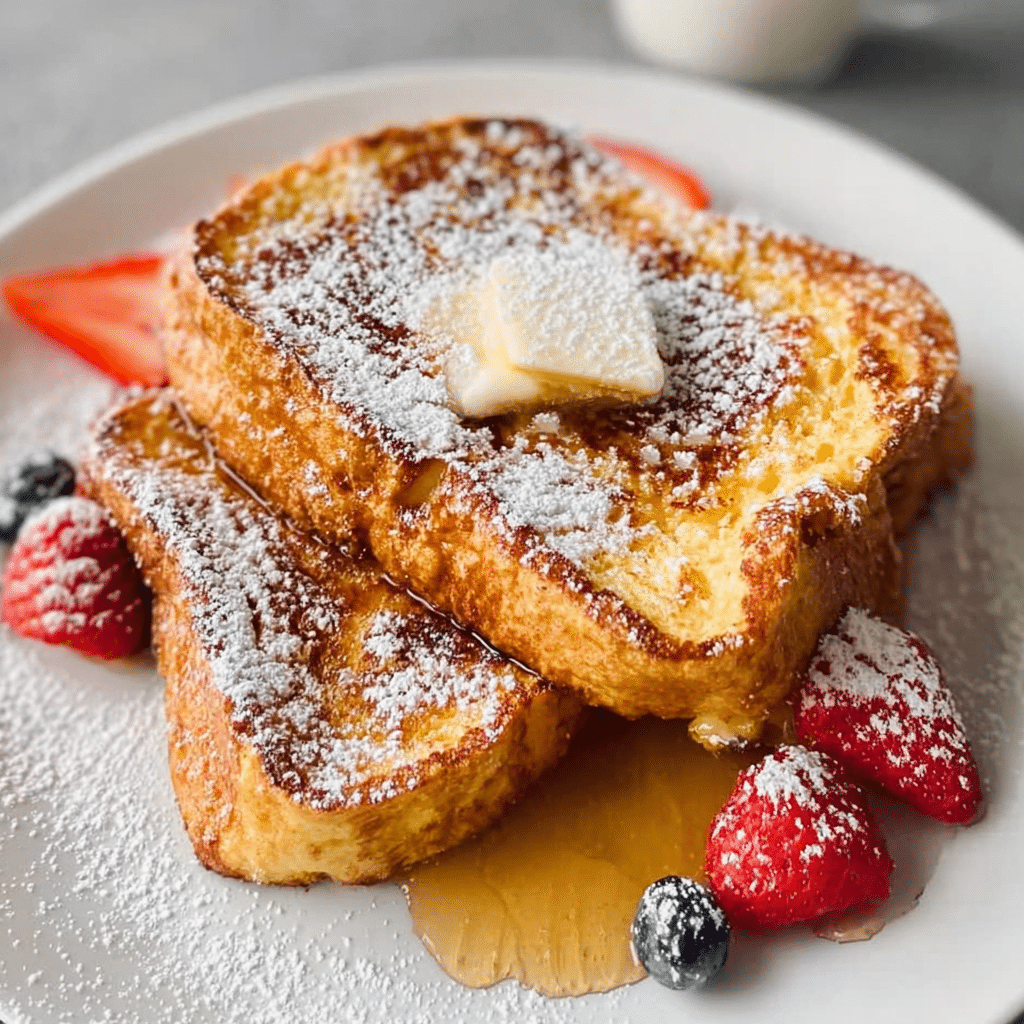
Flavor Variations for French Toast Breakfast
Transform your basic French Toast Breakfast into exciting flavor adventures with these tested variations. Each modification maintains the fundamental technique while adding unique taste profiles.
Sweet French Toast Breakfast Variations
Cinnamon Roll Style: Add an extra teaspoon of cinnamon to your custard base and drizzle finished French Toast with a simple glaze made from powdered sugar and milk.
Orange Zest Enhancement: Incorporate fresh orange zest and a tablespoon of orange juice into the custard for bright, citrusy French Toast Breakfast that pairs beautifully with berries.
Coconut Paradise: Replace half the milk with coconut milk and add shredded coconut to the custard mixture for tropical French Toast perfection.
Maple Pecan Delight: Stir pure maple syrup into the custard and top finished French Toast with toasted pecans and additional maple syrup.
Savory French Toast Breakfast Options
Herb and Cheese: Omit sugar from the custard, add fresh herbs like chives or thyme, and serve your French Toast Breakfast with grated cheese and fresh cracked pepper.
Everything Bagel Style: Season the custard with everything bagel seasoning for a unique savory French Toast experience that pairs well with cream cheese.
Global French Toast Breakfast Inspirations
French Pain Perdu: Use day-old brioche and finish with a dusting of powdered sugar and fresh berries for authentic French-style French Toast .
Spanish Torrijas: Soak bread in milk infused with cinnamon stick and lemon peel, then coat in beaten egg for this traditional Spanish version of French Toast .
Japanese Shokupan Style: Use thick-cut Japanese milk bread for incredibly fluffy French Toast with a uniquely tender texture.
Dietary-Specific French Toast Breakfast Adaptations
| Dietary Need | Custard Modification | Bread Choice | Cooking Adjustment |
|---|---|---|---|
| Dairy-Free | Coconut milk + almond milk | Standard bread | Same technique |
| Gluten-Free | Regular custard base | GF bread, extra soak time | Lower heat, longer cooking |
| Low-Sugar | Sugar-free syrup in custard | Whole grain bread | Standard method |
| High-Protein | Add protein powder to custard | Protein-enriched bread | Watch for faster browning |
| Vegan | Plant milk + flax eggs | Vegan bread | May need extra liquid |
This table provides quick reference for adapting your French Toast to various dietary requirements while maintaining delicious results.
Serving Suggestions for French Toast Breakfast
Elevate your French Toast presentation and flavor combinations with these carefully curated serving ideas that complement rather than compete with the main dish.
Classic French Toast Breakfast Accompaniments
Fresh Berry Medley: Combine strawberries, blueberries, and raspberries with a light honey drizzle. The natural acidity balances the rich French Toast Breakfast perfectly.
Whipped Cream Variations: Plain whipped cream, cinnamon-spiced whipped cream, or vanilla bean whipped cream add luxury to your French Toast presentation.
Syrup Selection: Pure maple syrup remains the gold standard, but consider trying buckwheat honey, agave nectar, or homemade berry syrups for unique French Toast experiences.
Nut Butter Combinations: Almond butter, natural peanut butter, or cashew butter provide protein and healthy fats that complement the carbohydrates in your French Toast .
Savory French Toast Breakfast Pairings
Breakfast Proteins: Turkey sausage links, Canadian turkey or chicken sausage create a balanced French Toast meal with both sweet and savory elements.
Vegetable Sides: Sautéed spinach, roasted tomatoes, or grilled asparagus add nutritional value and color contrast to your French Toast plate.
Egg Preparations: Scrambled eggs, poached eggs, or egg whites provide additional protein and create a more substantial French Toast Breakfast experience.
Beverage Pairings for French Toast
Coffee Selection: Medium-roast coffee with chocolate notes complements the vanilla and cinnamon in your French Toast without overwhelming the delicate flavors.
Tea Options: Earl Grey or English Breakfast tea provide subtle bergamot or malty notes that enhance the richness of French Toast .
Fresh Juices: Orange juice, apple cider, or cranberry juice offer refreshing acidity that cleanses the palate between bites of rich French Toast Breakfast.
Hot Beverages: Hot chocolate, spiced chai, or golden milk create cozy morning experiences perfect for leisurely French Toast enjoyment.
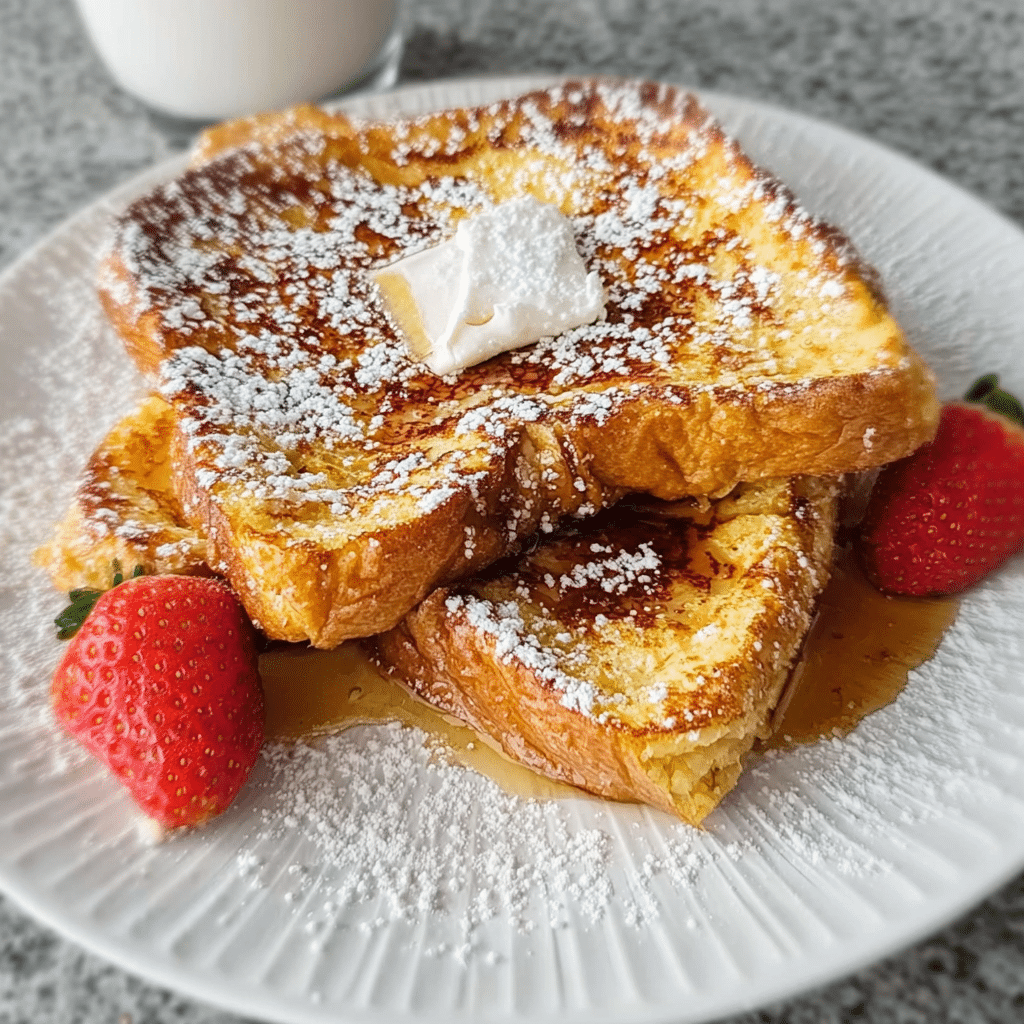
FAQs About French Toast Breakfast
These frequently asked questions address common concerns and troubleshooting issues that home cooks encounter when making French Toast .
Preparation French Toast Breakfast Questions
Q: Can I make French Toast Breakfast with frozen bread? A: Yes, but thaw the bread completely first and allow it to sit uncovered for 30 minutes to remove excess moisture. Frozen bread often becomes soggy during the French Toast soaking process if not properly prepared.
Q: How thick should I slice bread for French Toast Breakfast? A: Optimal thickness ranges from ¾ to 1 inch. Thinner slices become too soggy, while thicker slices may not cook through properly during the French Toast cooking process.
Q: What’s the best way to store leftover French Toast Breakfast custard? A: Refrigerate unused custard for up to 24 hours. Whisk thoroughly before using as ingredients may separate. Never reuse custard that has contacted raw bread for food safety reasons.
Cooking French Toast Breakfast Troubleshooting
Q: Why does my French Toast Breakfast turn out soggy? A: Soggy French Toast typically results from over-soaking bread, using too-fresh bread, or cooking at too low temperature. Use day-old bread and limit soaking time to achieve proper texture.
Q: How do I fix overcooked French Toast Breakfast? A: If your French Toast Breakfast is overcooked but not burnt, serve it with extra syrup or fruit compote to add moisture. Prevention involves using proper temperature and timing rather than attempting to fix overcooked results.
Q: Is this French Toast Breakfast recipe safe for pregnant women? A: Yes, when cooked to an internal temperature of 160°F, French Toast is safe during pregnancy. The cooking process eliminates any concerns about raw eggs in the custard mixture.
Storage and Reheating French Toast Questions
Q: Can I freeze cooked French Toast Breakfast? A: Absolutely! Cool completely, then freeze on a baking sheet before transferring to freezer bags. Frozen French Toast Breakfast keeps for up to 2 months and reheats beautifully in the toaster.
Q: What’s the best way to reheat French Toast Breakfast? A: For best results, reheat French Toast Breakfast in a 350°F oven for 5-7 minutes or toast frozen pieces directly in a toaster. Microwave reheating creates soggy texture and should be avoided.
Q: How long does French Toast Breakfast last in the refrigerator? A: Properly stored French Toast Breakfast remains fresh for 3-4 days refrigerated. Store pieces separately to prevent sticking and cover tightly to maintain moisture without creating sogginess.
Conclusion
This Classic French Toast Breakfast recipe represents years of testing and refinement to create the perfect balance of simplicity and sophistication. By following these detailed techniques and understanding the science behind each step, you’ll consistently produce restaurant-quality French Toast Breakfast that transforms ordinary mornings into special occasions.
The key to exceptional French Toast Breakfast lies in attention to detail: choosing the right bread, creating the perfect custard base, controlling cooking temperature, and understanding timing. These fundamentals, combined with the pro tips and variations shared throughout this guide, ensure your French Toast Breakfast will become a beloved family tradition.
Remember that cooking is a journey of discovery, and this French Toast Breakfast recipe provides the foundation for countless creative variations. Whether you prefer classic vanilla and cinnamon or adventurous global flavors, the techniques remain constant while the possibilities are endless.
Start your weekend mornings right with this foolproof French Toast Breakfast recipe, and watch as your kitchen becomes the heart of memorable family gatherings. The combination of crispy exteriors, custardy centers, and endless customization options makes this recipe a true keeper.
Fire up your stove and create this magnificent French Toast Breakfast tonight – your family will thank you! Join thousands of home cooks who’ve discovered the joy of perfect French toast through this tested recipe.
Ready to explore more breakfast perfection? Try our Fluffy Homemade Buttermilk Pancakes or Quick & Healthy Acai Bowl Recipe for more morning magic that pairs beautifully with this French Toast Breakfast recipe!
If you loved this recipe, don’t forget to share it with your friends or save it to try later! I’d be thrilled to see your personal touch—share your photos on Pinterest
Print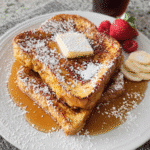
Classic French Toast Breakfast Recipe: The Ultimate Guide to Perfect Morning Bliss
- Total Time: 20 minutes
- Yield: 2 servings 1x
- Diet: Vegetarian
Description
A classic French Toast breakfast made with thick bread slices dipped in a cinnamon-vanilla egg mixture and cooked until golden brown. Perfect for a cozy morning meal!
Ingredients
4 slices thick bread (brioche or challah works best)
2 large eggs
1/2 cup milk
1 tbsp sugar
1 tsp vanilla extract
1/2 tsp ground cinnamon
1 tbsp butter (for frying)
Optional toppings: maple syrup, powdered sugar, fresh berries
Instructions
1. In a mixing bowl, whisk together eggs, milk, sugar, vanilla extract, and cinnamon until well combined.
2. Heat a skillet or non-stick pan over medium heat and add butter.
3. Dip each bread slice into the egg mixture, coating both sides evenly.
4. Place the soaked bread on the hot skillet and cook for 2–3 minutes per side until golden brown.
5. Remove from skillet and serve immediately with maple syrup, powdered sugar, or fresh berries.
Notes
For richer flavor, use day-old brioche or challah bread.
You can add a pinch of nutmeg for extra warmth.
Serve with whipped cream or honey for variety.
- Prep Time: 10 minutes
- Cook Time: 10 minutes
- Category: Breakfast
- Method: Pan-Fried
- Cuisine: American, French
Nutrition
- Serving Size: 2 slices
- Calories: 320
- Sugar: 10g
- Sodium: 220mg
- Fat: 14g
- Saturated Fat: 7g
- Unsaturated Fat: 5g
- Trans Fat: 0g
- Carbohydrates: 36g
- Fiber: 2g
- Protein: 12g
- Cholesterol: 130mg
Keywords: French Toast, Breakfast Recipe, Easy Brunch, Cinnamon Toast
